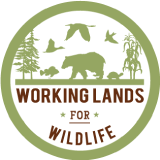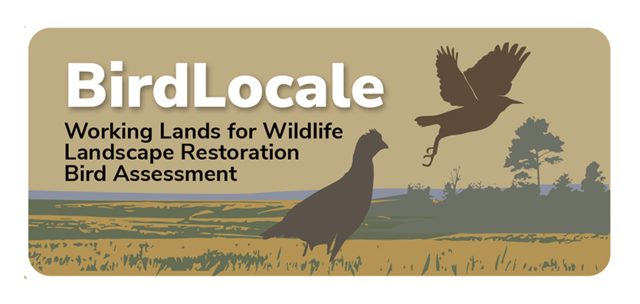-
 How fall covey counts track the impact of habitat restoration
How fall covey counts track the impact of habitat restoration
-
by
Rachel Holt
—
published
May 27, 2025
—
filed under:
WLFW,
Working Lands for Wildlife,
Northern Bobwhite Quail,
Grasslands and Savannas,
Outcomes Assessments,
Audio Recording Unit
Surveys provide critical insight into management practices for northern bobwhite quail.
Located in
Stories
-
 How hurricanes impact quail
How hurricanes impact quail
-
by
Rachel Holt
—
published
May 27, 2025
—
filed under:
WLFW,
Northern Bobwhite Quail,
Grasslands and Savannas,
Hurricanes,
Tropical Storms,
Florida,
Tall Timbers
STORMS SWEEPING THROUGH THE SOUTHEAST ARE A MIXED BAG FOR NORTHERN BOBWHITES
Located in
Stories
-
 Illinois Priority Area Shapefiles
Illinois Priority Area Shapefiles
-
by
Sage Voorhees
—
published
Mar 05, 2022
—
last modified
Apr 20, 2023 10:01 PM
—
filed under:
Information,
WLFW,
Central,
Northern Bobwhite Quail,
Illinois,
Boundaries & Priority Area Shapefiles,
Maps and Spatial Data,
Grasslands and Savannas,
Working Lands for Wildlife,
Central Region
Shapefiles for Northern Bobwhite Priority Areas
Located in
Information
/
…
/
Boundaries & Priority Area Shapefiles
/
Central Region
-
IN Workshop - Native grasses in Prescribed Grazing Systems
-
by
Bridgett Costanzo
—
published
Jun 13, 2019
—
last modified
Dec 06, 2024 07:01 PM
—
filed under:
Bobwhite,
News,
News & Events,
Native grasses,
WLFW,
Northern Bobwhite Quail,
Birds,
Workshop,
Prescribed Grazing,
Grasslands and Savannas,
Working Lands for Wildlife,
native grasslands,
forage
Using Native Warm-Season Grasses in a Grazing System
Participants will learn the latest research-supported methods for reliable native forage establishment and grazing management to maintain grass vigor and animal performance through the summer.
This training is being presented by The Center for Native Grasslands Management and NBCI through a grant provided by Quail Forever and the Natural Resources Conservation Service in support of the Working Lands For Wildlife: Bobwhite in Grasslands project.
Topics to be covered:
Bobwhite basics, bobwhite habitat considerations in grazing lands
Overview of native warm-season grass (NWSG) establishment
Why use NWSG in your grazing system – animal performance and economics
How to manage NWSG forages – maintaining vigor and productivity, impact on bobwhite and other grassland birds
NWSG in complementary cool-season grass systems.
Registration:
No registration fee, but registration is required.
Please RSVP to jhodge34@utk.edu.
Lunch will be provided to participants.
Located in
News
-
 Indiana Priority Area Shapefiles
Indiana Priority Area Shapefiles
-
by
Sage Voorhees
—
published
Mar 05, 2022
—
last modified
Apr 20, 2023 10:32 PM
—
filed under:
Information,
Central,
Grasslands and Savannas,
Northern Bobwhite Quail,
Boundaries & Priority Area Shapefiles,
Indiana,
Maps and Spatial Data,
WLFW,
Working Lands for Wildlife,
Central Region
Northern Bobwhite Priority Areas
Located in
Information
/
…
/
Boundaries & Priority Area Shapefiles
/
Central Region
-
 Innovative Conservation on the Sid Williams Ranch
Innovative Conservation on the Sid Williams Ranch
-
by
Gilbert Randolph
—
published
Apr 06, 2025
—
last modified
May 27, 2025 05:45 AM
—
filed under:
Working Lands for Wildlife,
Grasslands and Savannas,
Stories,
Northern Bobwhite Quail
“I’m addicted to taking a piece of land that’s worthless and turning it into something,” says Sid Williams, a rancher and landowner whose innovative conservation work in South Texas is making an outsized impact for bobwhite quail.
Located in
Stories
-
 It's All in the Soil
It's All in the Soil
-
by
Gilbert Randolph
—
published
Apr 06, 2025
—
last modified
May 27, 2025 05:42 AM
—
filed under:
Working Lands for Wildlife,
Grasslands and Savannas,
Stories,
Northern Bobwhite Quail
Do you know your dirt? A local USDA’s Natural Resource Conservation Service (NRCS) representative can help landowners get up to speed on what sort of ground they’re working with.
Located in
Stories
-
Join the Bobwhite in Hardwood Forested Systems Webinar!
-
by
Gilbert Randolph
—
published
Jan 21, 2025
—
filed under:
WLFW,
News & Events,
Grasslands and Savannas,
Bobwhite Quail Seminar Series,
News,
WLFW Conservation Webinar Series,
Bobwhite,
Working Lands for Wildlife
Join us February 13th at 11:30 AM CST for a webinar on Bobwhite in Hardwood Forested Systems. We will be joined by John Gruchy of the Mississippi Department of Wildlife, Fisheries and Parks.
Located in
News
-
 Kansas Priority Area Shapefiles
Kansas Priority Area Shapefiles
-
by
Sage Voorhees
—
published
Mar 05, 2022
—
last modified
May 07, 2025 11:06 PM
—
filed under:
Information,
Maps and Data,
WLFW,
Central,
Kansas,
Northern Bobwhite Quail,
Boundaries & Priority Area Shapefiles,
Grasslands and Savannas,
Working Lands for Wildlife,
Central Region
Northern Bobwhite Priority Areas
Located in
Information
/
…
/
Boundaries & Priority Area Shapefiles
/
Central Region
-
 Kentucky Priority Area Shapefiles
Kentucky Priority Area Shapefiles
-
by
Sage Voorhees
—
published
Mar 05, 2022
—
last modified
Apr 20, 2023 10:46 PM
—
filed under:
Information,
WLFW,
Northern Bobwhite Quail,
Kentucky,
Boundaries & Priority Area Shapefiles,
Southeast,
Maps and Spatial Data,
Grasslands and Savannas,
Working Lands for Wildlife
Priority Areas for Northern Bobwhite Conservation
Located in
Information
/
…
/
Boundaries & Priority Area Shapefiles
/
Southeast


